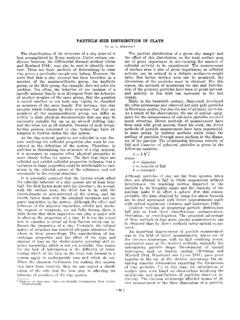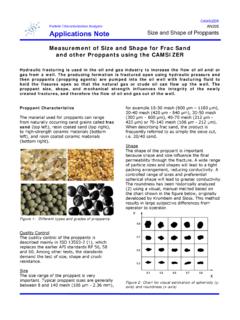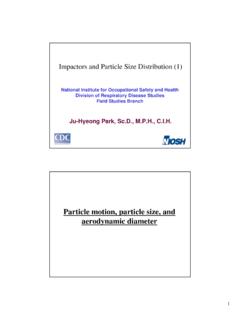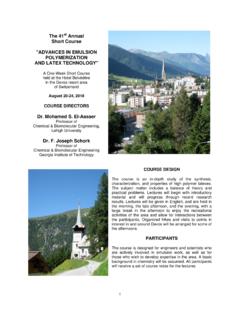Transcription of TECHNICAL NOTES 2 PARTICLE POPULATIONS AND …
1 2-1 TECHNICAL NOTES 2 PARTICLE POPULATIONS AND DISTRIBUTION IntroductionThe behavior of ore dressing equipment depends on the nature of the individual particles that are processed. Thenumber of particles involved is very large indeed and it would be quite impossible to base computational procedureson any method that required a detailed description of the behavior of each PARTICLE . The complexity of such procedureswould mean that any useful or meaningful models would be entirely out of the question. But the characteristics ofindividual particles do have to be taken into account and useful models cannot be developed if these are to be basedsimply on average properties of all the particles in the particles differ from each other in many respects: the differences that are of interest in ore dressingoperations are those physical properties that influence the behavior of a PARTICLE when subject to treatment in any oredressing equipment.
2 The two most important fundamental properties are the size of the PARTICLE and its mineralogicalcomposition. Other properties such as shape, specific gravity, fracture energy, surface area, surface energy and so onare also important and, in many ore dressing operations, can be of overriding significance. The operation ofcomminution and classification are primarily dependent on the size of the particles treated but the composition, specificgravity, brittleness and other properties can also influence the behavior of the particles to a greater or lesser extentduring treatment. Gravity concentration operations exploit primarily the differences in specific gravity between particlesand thus different mineral species can be separated from each other.
3 The various physical properties are not necessarily independent of each other. For example the specific gravity of asingle PARTICLE is uniquely fixed once the mineralogical composition is specified. Likewise the surface energy of aparticle will be specified by the mineral components that are exposed on the surface of the PARTICLE . Some definite scheme for the description of the properties of the particles in the PARTICLE population is required that willallow sufficient detail to permit the models to be sufficiently sensitive to individual PARTICLE properties but at the sametime sufficiently comprehensive to allow the economy of not having to define the properties of each individual a scheme is provided by a description using distribution functions.
4 Distribution functionsThe distribution function for a particular property defines quantitatively how the values of that property are distributedamong the particles in the entire population. Perhaps the best known and most widely used distribution function is theparticle size distribution function P(dp) defined by P(dp) = mass fraction of particles in the population with size lessthan or equal to dp. The symbol dp is used throughout these NOTES to represent the size of a function P(dp) has several important general properties:a)P(0) = 0b)P( ) = 1c)P(dp) increases monotonically from 0 to 1 as dp increases from 0 to .Properties a) and b) are obvious because no PARTICLE in the population can have a size less than or equal to 0 and all theparticles have a size less than infinity.
5 Property c) reflects the fact that the fraction of the population having size lessthan or equal to dp1 must contain at least all those particles of size dp2 or smaller, if dp2 dp1 .2-3Of course the concept of PARTICLE size is ambiguous. particles that are of interest in mineral processing do not haveregular definable shapes such as spheres and cubes. The size of a spherical PARTICLE can be unambiguously defined asthe diameter. Likewise the size of a cube can be defined unambiguously as the length of a side but another dimensioncould be equally well used such as the longest diagonal. PARTICLE size clearly does not have a unique meaning even forparticles with regular shapes. In mineral processing technology an indirect measure of size is used.
6 The size of aparticle is defined as the smallest hole opening in a square-mesh screen through which the PARTICLE will fall. Sometimesit is necessary to work with particles that are too small to measure size conveniently by means of screening. Then otherappropriate indirect measures are used such as the terminal falling velocity in a fluid of specified viscosity and practical applications it is convenient and often essential to make use of a discrete partioning of the length scale sothat the PARTICLE population is divided conceptually into groups each identified by the smallest and largest size in value of P can be measured experimentally at a number of fixed sizes that correspond to the mesh sizes of the setof sieves that are available in the laboratory.
7 This data is usually presented in tabular form showing mesh size againstfraction smaller than that mesh. Graphical presentations are useful and are often preferred because it is generally easierto assess and compare PARTICLE size distributions when the entire distribution function is immediately visible. A varietyof different graphical coordinate systems have become popular with a view to making the distribution function plot asor close to a straight line. The PARTICLE size axis is usually plotted on a logarithmic coordinate scale. The ordinate scaleis calibrated according according to the distribution function P(dp) is close to a prespecified distribution. Specially ruledgraph papers are available for this purpose and these can be easily drawn by mesh sizes in the standard sieve series vary in geometric progression because experience has shown that such aclassification will leave approximately equal amounts of solids on each of the test sieves in a screen analysis.
8 Thus eachmesh size is a constant factor larger than the previous one. The constant factor is usually 4 2 or 2 . The mesh sizesin such a series will plot as equidistant points on a logarithmic the distribution function P(dp) is perfectly well defined and is amenable to direct measurement in thelaboratory, it is not directly useful for modeling ore dressing unit operations. For this purpose the derived densityfunction is used. The discrete PARTICLE size density function pi(dp) is defined as follows:pi(dp) PDi 1 DidP(dp) P(Di 1) P(Di) Pi mass fraction of the PARTICLE populationthat has size betweenDi 1andDi( )pi(dp) is called the fractional discrete density function and the argument dp is often dropped if there is no risk ofconfusion.
9 Dp = Di-1 - Di is the so-called size class width and is usually not constant but varies from size to size . The finite widthof the size class defined by dp is very important in the development of the modeling techniques that are used. The ideaof a particular size class is central to the development of our modeling procedure. The size class is considered2-4conceptually to include all particles in the entire population that have size falling within the class boundaries dp anddp+ dp. It is customary to designate the class boundary by means of a subscript and in order to distinguish the classboundaries clearly they will always be denoted by the symbol Di which indicates the lower boundary of size class the entire PARTICLE population is conceptually classified into classes each one of which is defined by its upper andlower boundary.
10 It is conventional to run the number of the classes from larger sizes to smaller. Thus Di Di+1 . Thetop size class has only one boundary D1 and it includes all particles which have size greater than D1 .The concept of the PARTICLE classes effectively allows us to formulate models for extractive metallurgical systems bydescribing the behaviour of classes of particles rather than the behavior of individual particles . A representative sizeis associated with each PARTICLE size class and it is assumed that all particles in the class will behave in our processingsystems as if it had a size equal to the representative size . Clearly this will be a viable working assumption only if thesize class is sufficiently narrow.











